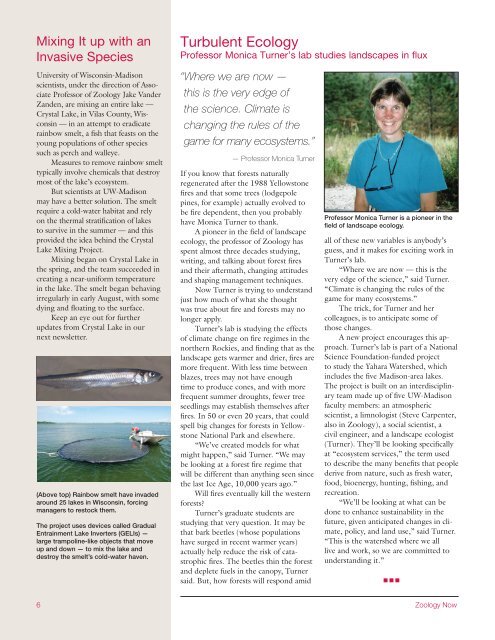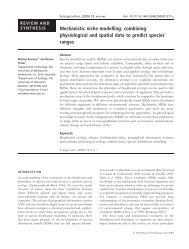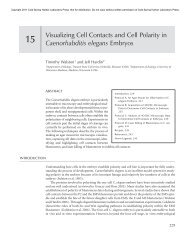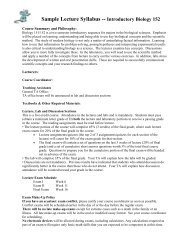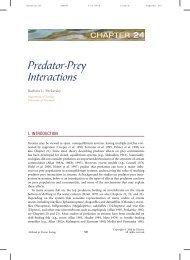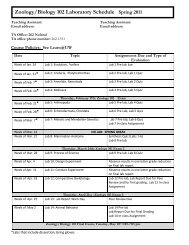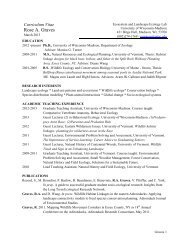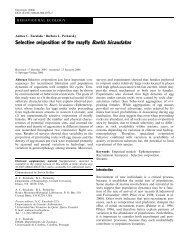Zoology Newsletter - Department of Zoology - University of ...
Zoology Newsletter - Department of Zoology - University of ...
Zoology Newsletter - Department of Zoology - University of ...
You also want an ePaper? Increase the reach of your titles
YUMPU automatically turns print PDFs into web optimized ePapers that Google loves.
Mixing It up with anInvasive Species<strong>University</strong> <strong>of</strong> Wisconsin-Madisonscientists, under the direction <strong>of</strong> AssociatePr<strong>of</strong>essor <strong>of</strong> <strong>Zoology</strong> Jake VanderZanden, are mixing an entire lake —Crystal Lake, in Vilas County, Wisconsin— in an attempt to eradicaterainbow smelt, a fish that feasts on theyoung populations <strong>of</strong> other speciessuch as perch and walleye.Measures to remove rainbow smelttypically involve chemicals that destroymost <strong>of</strong> the lake’s ecosystem.But scientists at UW-Madisonmay have a better solution. The smeltrequire a cold-water habitat and relyon the thermal stratification <strong>of</strong> lakesto survive in the summer — and thisprovided the idea behind the CrystalLake Mixing Project.Mixing began on Crystal Lake inthe spring, and the team succeeded increating a near-uniform temperaturein the lake. The smelt began behavingirregularly in early August, with somedying and floating to the surface.Keep an eye out for furtherupdates from Crystal Lake in ournext newsletter.(Above top) Rainbow smelt have invadedaround 25 lakes in Wisconsin, forcingmanagers to restock them.The project uses devices called GradualEntrainment Lake Inverters (GELIs) —large trampoline-like objects that moveup and down — to mix the lake anddestroy the smelt’s cold-water haven.Turbulent EcologyPr<strong>of</strong>essor Monica Turner’s lab studies landscapes in flux“Where we are now —this is the very edge <strong>of</strong>the science. Climate ischanging the rules <strong>of</strong> thegame for many ecosystems.”— Pr<strong>of</strong>essor Monica TurnerIf you know that forests naturallyregenerated after the 1988 Yellowstonefires and that some trees (lodgepolepines, for example) actually evolved tobe fire dependent, then you probablyhave Monica Turner to thank.A pioneer in the field <strong>of</strong> landscapeecology, the pr<strong>of</strong>essor <strong>of</strong> <strong>Zoology</strong> hasspent almost three decades studying,writing, and talking about forest firesand their aftermath, changing attitudesand shaping management techniques.Now Turner is trying to understandjust how much <strong>of</strong> what she thoughtwas true about fire and forests may nolonger apply.Turner’s lab is studying the effects<strong>of</strong> climate change on fire regimes in thenorthern Rockies, and finding that as thelandscape gets warmer and drier, fires aremore frequent. With less time betweenblazes, trees may not have enoughtime to produce cones, and with morefrequent summer droughts, fewer treeseedlings may establish themselves afterfires. In 50 or even 20 years, that couldspell big changes for forests in YellowstoneNational Park and elsewhere.“We’ve created models for whatmight happen,” said Turner. “We maybe looking at a forest fire regime thatwill be different than anything seen sincethe last Ice Age, 10,000 years ago.”Will fires eventually kill the westernforests?Turner’s graduate students arestudying that very question. It may bethat bark beetles (whose populationshave surged in recent warmer years)actually help reduce the risk <strong>of</strong> catastrophicfires. The beetles thin the forestand deplete fuels in the canopy, Turnersaid. But, how forests will respond amidPr<strong>of</strong>essor Monica Turner is a pioneer in thefield <strong>of</strong> landscape ecology.all <strong>of</strong> these new variables is anybody’sguess, and it makes for exciting work inTurner’s lab.“Where we are now — this is thevery edge <strong>of</strong> the science,” said Turner.“Climate is changing the rules <strong>of</strong> thegame for many ecosystems.”The trick, for Turner and hercolleagues, is to anticipate some <strong>of</strong>those changes.A new project encourages this approach.Turner’s lab is part <strong>of</strong> a NationalScience Foundation-funded projectto study the Yahara Watershed, whichincludes the five Madison-area lakes.The project is built on an interdisciplinaryteam made up <strong>of</strong> five UW-Madisonfaculty members: an atmosphericscientist, a limnologist (Steve Carpenter,also in <strong>Zoology</strong>), a social scientist, acivil engineer, and a landscape ecologist(Turner). They’ll be looking specificallyat “ecosystem services,” the term usedto describe the many benefits that peoplederive from nature, such as fresh water,food, bioenergy, hunting, fishing, andrecreation.“We’ll be looking at what can bedone to enhance sustainability in thefuture, given anticipated changes in climate,policy, and land use,” said Turner.“This is the watershed where we alllive and work, so we are committed tounderstanding it.”n n n6 <strong>Zoology</strong> Now


